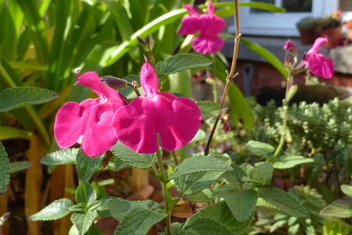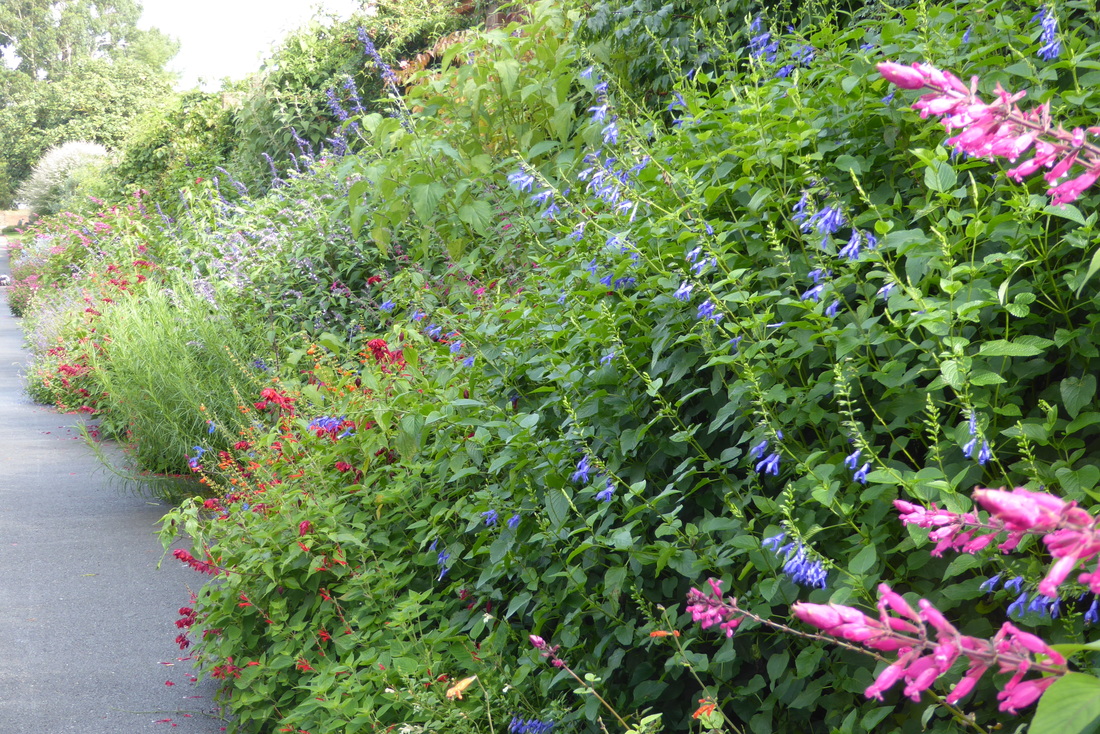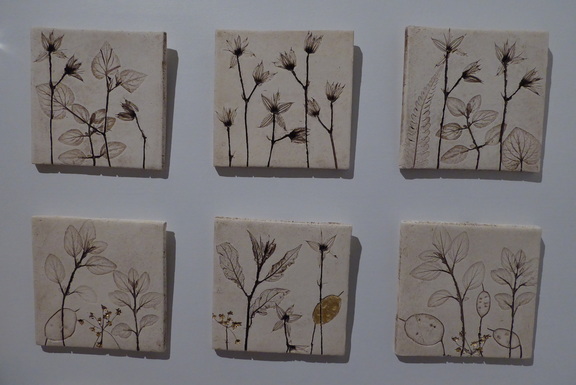One I particularly love is the Japanese Anemone, also sometimes called windflower. The botanical name is Anemone hupehensis, or A. h. var. japonica for the original plant I believe, but many in cultivation will be of mixed parentage and hence called Anemone x hybrida. They can be real thugs in the garden, especially the common light pink form - but oh, I easily surrender to this thug's charms. Having said that I much prefer the single white ones, though, the best known probably being the cultivar 'Honorine Jobert'. For years I had mine in a big pot, occasionally changing its soil, but after the first few years powdery mildew and other diseases blighted the show.
I've heard that 'Honorine Jobert' is slow to establish and can be a bit difficult - at least compared to other Japanese anemones - but I doubt this was the reason here. It probably just isn't happy in the pot - simple as that: not enough room, perhaps too dry occasionally in between waterings... And once fungal diseases have successfully attacked a plant that wasn't very vigorous in the first place, it's hard to get rid of them, no matter how diligently you pick off any dead leaves/ infected stalks etc.. I would need to move the plant to a more suitable "spot" to get rid of the problem, and this is what I am going to do soon. However, it means 'Honorine Jobert' won't grow in my garden anymore but someone else's.
It's difficult to make a direct comparison between the two since a sickly specimen in a pot is not match for a healthy one in the ground (so I haven't really seen them grow side by side). But I believe 'Andrea Atkinson' grows not as tall as its better known counterpart (backed up by the RHS website which puts 'H.J.' at 1 - 1.5m and 'A.A.' at 0.5 - 1m ultimate height though mine is certainly more than that) yet is more vigorous and flowers for a longer period. In my garden, 'Andrea's first blooms usually open in early August and there are still some around now.
I absolutely adore these cheer- yet graceful open-faced blooms that seem to dance and float above the sturdy mid- to dark green leaves. From the marble-like buds to when they have lost their tepals and only the small, light green globules remain, covered in what looks like tiny black hair. (When in bloom, these central "globules" are just a fresh yellowy green - but later they develop this dark pattern that close-up makes them appear a bit like a fly's eye). These remain on the plant for a long time, eventually turning brown and then - in winter - disintegrating into whitish fluff that disperses the seed (and is beloved by our goldfinches).
While Japanese anemones can become thugs due to their vigorous spreading, in my small garden I find it no problem to keep on top of them. In fact, I wish I could let them spread more. As it is though, I'll rip out any shoot that strays from its allocated spot, which I find not too difficult and they root easily enough so I have spare plants to give away. I haven't noticed any "invasion" due to long runners or such like: the new shoots usually are in the close vicinity of the mother plant.
Similarly spreading from the original base is my second staple plant for this time of year: Tricyrtis formosana, the toad lily. Another, more complimentary name is "Poor Man's Orchid" which seems far more appropriate. Not a lurid, diva-esque orchid - one of the more quieter types though, with its many purple spots on whitish background. However, it isn't an orchid in the least - it belongs to the lily family. Tricyrtis apparently loves humus-rich soil in a (semi-)shady spot, but has done well on my London clay. I did add spent multipurpose compost from pots over the years to break the clay up a bit, and this has helped I guess.
When my toad lily first bloomed after planting, I was disappointed: that was all??? Long strong stems with alternate, lance-shaped mid green leaves with darker spots - remotely looking like Salomon's Seal I thought, though stiffer in appearance - yet just a handful of small (albeit very pretty) star-shaped blooms at the very tip?? But this, as it turned out, was just the start. For weeks - nae months! - the plant would produce more and more buds from its leaf axils, unstoppably so it seemed. It has repeated that trick every year since: the first bud opening around mid-August and not finishing until well into November.
You just need to make sure the toad lilies do not dry out, especially so in spring. Last year's was a dry one and I didn't notice early enough just how dry that particular spot in the shade of the wall and overhung by ivy had become. The result was pitiful. At first I actually thought that the shoots were slowly dying from some fungal root pest or larvae perhaps, as I've had lots of trouble with wine weevils. Despite subsequent watering, last autumn the display was a mere shadow of the plant's former self, but luckily it has bounced back this year and seems intent on flowering its socks off again.
The third in my autumn trio is a classic Michaelmas Daisy: Aster novae-angliae 'Andenken an Alma Poetschke'. It's the only Michaelmas Daisy I'm able to recognise (and name) anywhere, as it has such an outstanding colour. Mine is in the same narrow bed as the English Rose 'Gertrude Jekyll' I wrote about earlier in the year, but in a spot with less light: semi-sunny at best I should say. It does not seem to mind but puts on a good show each year, only sullied by the fact that I never seem to be able to stake it properly and on time. Definitely one thing for the New (Gardening) Year's Resolutions list - except that I do not believe in (nor make) New Year's Resolutions... Perhaps I should. More to the point, I really should learn how to stake or support plants properly.
There are so many wonderful asters, I really should like to plant a whole autumn garden dedicated to them. But having room for one aster only, the choice was clear. Now, for a few weeks each year, 'Alma' meets 'Andrea' in my garden and the two ladies seem to be the best of friends: the magenta Aster complemented well by the white Japanese anemone growing nearby. I always feel a little sad when 'Andrea' bids her farewell and 'Alma' is left on her own, even though there is still blue 'Rozanne' (the Geranium) at her feet to keep her company. (As well as a great number of greens, yellows, russets and ochres from all sorts of leaves, of course.)
Last year I couldn't resist the call of another aster offered full of buds at my local supermarket: the label said Aster Island 'Samoa' which a quick research on the internet revealed to be Aster novae-belgii 'Samoa' of the Island series (there are several other breeds in this series named after exotic islands). It's a dwarf aster in a lovely blue-purple and specifically marketed for use "as a central feature in tubs and containers". And that's where I keep it. While last year it adhered to the 30 cm height limit given on the label, this year it was definitely 40 cm or more. Neither did it flower from June to August as advised but started in August and is still going strong! Definitely one for keeping. Especially since the colour - at least to my eye - seems to be matching that of Geranium 'Rozanne'.
Salvias to the fore
Apart from the climber-creeper, seasonal bedding plants in pots and the trio (or quartet) mentioned above, it is especially the salvias that provide colour in my autumn garden. And what jewel colours! My star performers are magenta-pink Salvia microphylla 'Cerro Potosi', dark purple Salvia 'Nachtvlinder' and scarlet Salvia elegans, the Pineapple Sage (the latter going really well with the Parthenocissus). Of 'Cerro Potosi' the experts at Salvia specialist Dyson's Nurseries say: "If you only have room for one salvia, then grow this one." High praise indeed. All three mentioned above go on flowering for months and months - often starting in early summer already, and I've had Pineapple sage flowers at Christmas. That is, of course, if no frost stops them before.
I keep my salvias out of doors all winter long, albeit with a loose covering of bubble wrap around several pots when there is a danger of temperatures dipping below freezing point. Still, I guess that's a bit risky. (Not least because I may not know in advance - I'm not avidly following the forecast - or may not find the time to wrap them.) But I do not have much choice as I don't have a cool room anywhere, no greenhouse or cold frame and certainly no room inside for pots full of cuttings.
Otherwise, that would be the recommended course of action: to take cuttings, at least as an insurance policy. (Better be safe than sorry...) Cuttings of salvias root incredibly easy, incredibly quickly and they also grow very quickly into good plants come next spring. On the up side for me: this is Inner London, we hardly ever get frost - especially in a sheltered "walled garden" like my south-facing patio. And some (non-native) salvias are hardy, too, apparently - at least if planted in full sun and free-draining soil. (Obviously, native sages like Meadow Clary (Salvia pratensis) are able to cope with our climes, but these do not bloom for such a long time into autumn.)
I also notice that they, or at least 'Cerro Potosi', are heavy feeders. As I have all my salvias in pots, I regularly repot into new soil and/or use slow-release fertilizer. If I forget, I'll soon notice the difference: instead of lots of flowers and lush green leaves on many strong shoots, there are very few flowers, few new shoots and the leaves on those are markedly smaller and turn anaemic and yellow. But, given a feed, they fairly quickly pick up again.
If all the above on salvias doesn't sound convincing though, I suggest you go and see the salvia border in Kew Gardens which had me in raptures when I first stumbled upon it. I also dare you to not lose your heart to some of the jewels in Dyson's Nurseries salvia catalogue or in The Plant Lover's Guide to Salvias, a Timber Press book by John Whittlesey in association with the Royal Botanic Gardens, Kew.
(P.S. Perhaps I should add that of the ones in my garden only 'Nachtvlinder' came from Dyson's and was as much an impulse buy as any... some others arrived as cuttings, over the fence, so to speak or from a charity sale.)
















 RSS Feed
RSS Feed